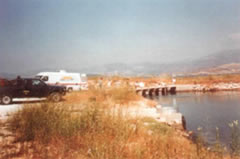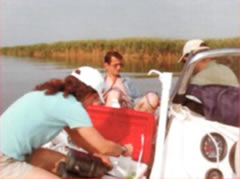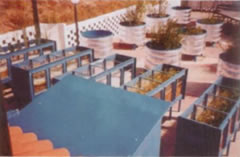The Laboratory participates the following EU-funded Research Projects:
- INTERREG IIIc: BEACHMED-e ("Strategic management of beach protection measures for the sustainable development of coastal areas")
- Pythagoras II (Support of University Research Groups)
- INTERREG IIIb: MEDOCC/HYDRANET
- INTERREG IIIa - PHARE CBC Greece-Bulgaria
Further, research activities of the Laboratory include among others:
Research in Nestos River Lagoons
 A systematic program of physical and chemical parameters monitoring has been designed and is carried out in Nestos' River Lagoons "Vassova" and "Eratino". The program examines the circulation in the water body, and records instantaneous and large time scale exchanges of water, salts and nutritious salts through the inlets of the Lagoons. Field data of hydrographic and quality parameters of the system are collected for small and large tidal cycles and for winter and summer conditions, in order to monitor the tidal and seasonal variability of the Lagoons.
A systematic program of physical and chemical parameters monitoring has been designed and is carried out in Nestos' River Lagoons "Vassova" and "Eratino". The program examines the circulation in the water body, and records instantaneous and large time scale exchanges of water, salts and nutritious salts through the inlets of the Lagoons. Field data of hydrographic and quality parameters of the system are collected for small and large tidal cycles and for winter and summer conditions, in order to monitor the tidal and seasonal variability of the Lagoons.
A Fuzzy Model for the Lagoons parameters:
Exploration of Strymon River salt wedge
 The limited river water supply in the Strymon River estuary, which is attributed to the construction of the Kerkini Lake dam, results to a salt wedge that extends a long distance upstream of the estuary. The salt wedge renders the river water inadequate for irrigation. A detailed data collection network has been designed for the monitoring of the qualitative and quantitative parameters of the field upstream of the outlet of Strymon River estuary. Field studies are performed every summer (when the wedge reaches its maximum extent), while a model of the flow field is under construction.
The limited river water supply in the Strymon River estuary, which is attributed to the construction of the Kerkini Lake dam, results to a salt wedge that extends a long distance upstream of the estuary. The salt wedge renders the river water inadequate for irrigation. A detailed data collection network has been designed for the monitoring of the qualitative and quantitative parameters of the field upstream of the outlet of Strymon River estuary. Field studies are performed every summer (when the wedge reaches its maximum extent), while a model of the flow field is under construction.
Natural systems for the treatment of wastewater
 Constructed wetlands for the treatment of urban, industrial and agricultural wastewater are used widely throughout the world. Design parameters for those systems are typically derived from the study of large scale units, while studies in pilot or laboratory units are limited. Experiments under controlled conditions are essential, however, for the understanding of the processes that take place in those systems. Five pilot units of constructed wetlands of horizontal subsurface flow and five units of surface flow have been designed and built and are now operating in the Laboratory facilities. These units are fed with wastewater and their performance in removal of various pollutants is continuously recorded.
Constructed wetlands for the treatment of urban, industrial and agricultural wastewater are used widely throughout the world. Design parameters for those systems are typically derived from the study of large scale units, while studies in pilot or laboratory units are limited. Experiments under controlled conditions are essential, however, for the understanding of the processes that take place in those systems. Five pilot units of constructed wetlands of horizontal subsurface flow and five units of surface flow have been designed and built and are now operating in the Laboratory facilities. These units are fed with wastewater and their performance in removal of various pollutants is continuously recorded.
Phosphorus and Nitrogen release from Lagoon sediments
This program studies the conditions of Phosphorus and Nitrogen release from eutrophic Lagoons sediments. The program includes field studies and laboratory analyses of nutrients that are traced in various forms in both the water body and the sediments and in the water trapped in porous sediment lumps as well. An experimental simulation of the sediment- water system is studied in appropriately designed reactors, in order to investigate the Phosphorus and Nitrogen release conditions from the sediment to the water body. The program aims to test in the Laboratory several environmental-friendly techniques for the restoration of polluted ecosystems and to suggest an optimal technique, for future application in real scale.
Research of the Thrace underground water systems
 This program evaluates the development and application of an integrated methodology for the management of water resources, trying to understand the operation of the system and the mechanism of pollutants transfer to the groundwater bodies. The aim of the program is the development of appropriate management techniques that will be based on a Decision Support System. Basic geological and hydrogeological research is included in the methodology. Special emphasis is put on hydrochemical and isotopic analysis and correlation, and on modeling of mechanisms of transfer and diffusion of pollutants, while optimization models are also developed in a GIS environment. The integrated nature of the research in this program is in accordance to the modern international practice for research on qualitative problems in groundwater.
This program evaluates the development and application of an integrated methodology for the management of water resources, trying to understand the operation of the system and the mechanism of pollutants transfer to the groundwater bodies. The aim of the program is the development of appropriate management techniques that will be based on a Decision Support System. Basic geological and hydrogeological research is included in the methodology. Special emphasis is put on hydrochemical and isotopic analysis and correlation, and on modeling of mechanisms of transfer and diffusion of pollutants, while optimization models are also developed in a GIS environment. The integrated nature of the research in this program is in accordance to the modern international practice for research on qualitative problems in groundwater.
Solution of the Forchheimer equation
 This program includes development of software for the solution of Forchheimer equation; the software will be able to simulate changes in head levels. Further, a group of analytical solutions has been developed for control of the numerical results and for better understanding of the hydrodynamic flow in porous materials when the inertia terms are significant. The development of experimental simulations in the Laboratory is in progress; these simulations will confirm the analytical and numerical solutions. Possible application areas for the results of this program include simulation of the processes taking place in aquifers, agricultural applications related to irrigation and drainage of the water, and better understanding of the processes in subsurface flow constructed wetlands.
This program includes development of software for the solution of Forchheimer equation; the software will be able to simulate changes in head levels. Further, a group of analytical solutions has been developed for control of the numerical results and for better understanding of the hydrodynamic flow in porous materials when the inertia terms are significant. The development of experimental simulations in the Laboratory is in progress; these simulations will confirm the analytical and numerical solutions. Possible application areas for the results of this program include simulation of the processes taking place in aquifers, agricultural applications related to irrigation and drainage of the water, and better understanding of the processes in subsurface flow constructed wetlands.

